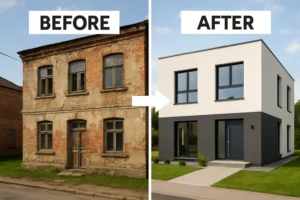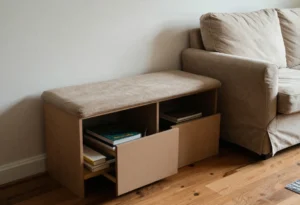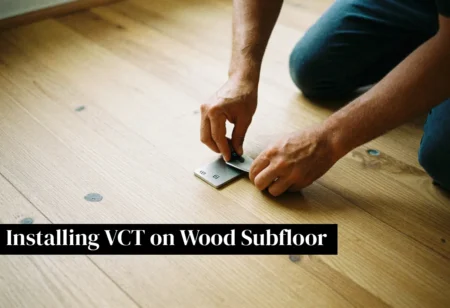The flooring you choose for your home has a significant environmental impact. Traditional flooring materials like vinyl, laminate, and carpet come with heavy ecological footprints from resource extraction, manufacturing processes, and end-of-life disposal. However, sustainable flooring options are available that are gentler on the planet.
In this comprehensive guide, we will explore the benefits of eco-friendly flooring, survey popular sustainable materials, examine the impact of hardwood floors, provide tips for homeowners, and showcase real-life examples of green flooring installs. Equipped with insights from environmental experts, our goal is to empower you to make informed flooring decisions to reduce your home’s carbon footprint.
Introduction to Sustainable Flooring
Floors cover a large surface area in homes, so flooring choices can greatly affect the sustainability of a dwelling. In fact, the EPA estimates that replacing flooring generates over 4 million tons of landfill waste annually in the US. Traditional carpeting, one of the most widely used flooring materials, is made from non-renewable fossil fuels and contains harmful VOC emissions. Meanwhile, the harvesting of old-growth forests for hardwood floors contributes to deforestation.
Clearly, standard flooring materials impose a significant environmental toll. The solution lies in sustainable options that reduce resource depletion, energy use, pollution, and waste. Eco-friendly floors even provide health benefits by improving indoor air quality. As green building expert Jason Graboski explains, “Sustainable flooring keeps toxins out of your home while lowering ecological impact. It’s better for you and the planet.”
When designing or renovating your home, take time to research environmentally friendly flooring. A little upfront investment in sustainable materials will pay dividends for years through lower energy bills, healthier living spaces, and reduced environmental footprints.
Benefits of Eco-Friendly Flooring
Before surveying materials, let’s explore the key advantages of sustainable flooring:
Reduced Resource Depletion
Eco-friendly flooring consumes fewer limited resources like lumber and fossil fuels. Materials are often harvested from rapidly renewable sources like bamboo or recycled from waste streams.
Lower Carbon Footprint
Sustainable flooring manufacturers utilize renewable energy and efficient processes to minimize greenhouse gas emissions. Also, materials like wood sequester carbon naturally.
Healthier Indoor Environments
Natural, non-toxic floors keep VOCs and irritants out of the home. This leads to better indoor air quality and reduced risk of conditions like asthma.
Biodegradable and Recyclable Materials
Most eco-floors can be composted or recycled at end of life. This leads to less landfill waste.
Durability and Longevity
Sustainable options like reclaimed wood or cork can last for decades with proper care, reducing the need for replacement.
Local and Sustainable Sourcing
Eco-friendly brands often use regional supplies and responsible harvesting practices that support local economies.
Lower Embodied Energy
Green floors require less energy-intensive processing and transportation, reducing embodied energy.
As you can see, sustainable flooring provides widespread environmental and health benefits for a relatively small upfront investment.
Popular Sustainable Flooring Options
Many natural and recycled options exist for eco-conscious homeowners. Let’s explore some of the most popular green flooring materials available:
Bamboo
Bamboo is a fast-growing grass that offers a renewable and durable flooring resource. Bamboo reaches maturity in just 5-7 years compared to 50 years for hardwoods. It requires no replanting and grows well without pesticides. Bamboo floors have a contemporary, light-toned appearance. They offer good moisture-resistance but require sealing to prevent water damage in kitchens or baths.
Cork
Harvested from the bark of cork oak trees, cork is antimicrobial, sound-absorbing, and comfortable underfoot. Cork grows back rapidly without harming trees. Available in various colors and patterns, cork works well in most rooms but may show indentations from heavy furniture. It’s impervious to moisture.
Reclaimed Wood
Wood from old barns, factories, and buildings is refurbished into durable flooring full of character. Reclaimed wood prevents useful materials from ending up in landfills. Maple, oak, and pine are common choices. Reclaimed floors may be uneven or need sanding before finishing.
Linoleum
Linoleum is a green flooring made from all-natural materials like solidified linseed oil, cork, wood flour, and jute fiber. Available in versatile tiles or sheets, linoleum is biodegradable, antimicrobial, and durable. It’s more scratch-resistant than vinyl but may stain or fade over time.
Wool Carpet
Sustainably sourced wool makes for a soft, hypoallergenic carpet with minimal off-gassing. Wool is naturally soil and moisture resistant. Look for carpets certified by groups like the Rainforest Alliance. Expect to pay more for eco-friendly wool.
Concrete
Stained, polished, or painted concrete utilizes existing slabs as finished flooring. This saves resources and landfill space. Concrete requires no toxic adhesives or manufacturing. Its thermal mass can reduce heating and cooling bills. Concrete floors are durable but very hard.
LVT (Luxury Vinyl Tile)
LVT contains polyvinyl chloride (PVC) plastic but is a better option than standard vinyl. Many brands use recycled content or environmentally responsible additives. Waterproof and scratch-resistant, LVT mimics wood or stone visually. Off-gassing of VOCs can be a concern.
Ceramic and Stone Tile
Made from natural clay and minerals, ceramic tile contains no VOCs and resists moisture. Porcelain tiles with recycled content are available. Stone tile like granite, limestone, or slate use natural resources but are very durable. Tile requires sealing and can be cold underfoot.
This overview shows that many eco-friendly options exist for sustainable floors. Always verify environmental claims by manufacturers and third-party certifications. Now let’s focus on a popular but sometimes controversial category: hardwood.
Environmental Impact of Hardwood Flooring
Hardwood floors allow homeowners to install beautiful wood interiors. However, some hardwoods have heavy environmental footprints. Others can provide sustainable options if responsibly sourced.
The benefits of hardwood include:
- Timeless, attractive aesthetics using natural materials
- Value boosting – hardwood floors increase home resale prices
- Longevity – hardwoods can last 100 years with refinishing
- Healthier than carpeting which can accumulate allergens
However, potential downsides exist:
- Depletes slow-growth forests if using threatened tree species
- Energy-intensive manufacturing and finishing processes
- Adhesives and coatings may contain harmful VOCs
- Potential for illegal “greenwashing” of unsustainable sources
Sourcing matters for the eco-impact of hardwoods. Old-growth tropical woods like mahogany or teak are unsustainable. More responsible options include:
Domestic Woods – U.S.-sourced oak, maple, ash, and pine have lighter footprints. Look for Forestry Stewardship Council (FSC) certification.
Rapidly Renewable Woods – Bamboo, acacia, and eucalyptus reach maturity quickly and regenerate rapidly.
Reclaimed Lumber – Refurbished from buildings, factories, and barns, reclaimed wood is a sustainable choice.
Responsibly Harvested Tropical Woods – Though challenging to verify, some tropical woods like jarrah are harvested ethically. Seek third-party verification.
With mindful sourcing and finishes, hardwoods can be an eco-friendly flooring choice. Verify sustainability claims and forestry certifications when selecting your materials.
Considerations for Homeowners
Ready to shop for sustainable floors? Here are some tips:
- Check certifications – Trustworthy eco-labels include GreenGuard, FloorScore, and FSC. This verifies environmental claims.
- Calculate full lifecycle impact – Consider the floor’s expected lifespan and maintenance requirements. A 50-year stone floor may be greener than 20-year linoleum requiring multiple replacements.
- Factor in cleaning requirements – Some green floors need chemical cleaners or protective finishes that undermine sustainability. Opt for low-maintenance materials.
- Read the fine print – Some bamboo or wood Some bamboo or wood is falsely marketed as sustainable. Read labels carefully and research sources.
- Prioritize durability – Floors that endure decades without replacement conserve resources. Reclaimed oak or porcelain last practically forever.
- Watch out for VOCs – Even green options like recycled rubber floors can off-gas. Opt for low or no-VOC products.
- Consider installation – Glue-down floors use adhesives with toxic ingredients in the lungs. Floating floors avoid these.
- Compare insulation factor – Some floors like cork provide natural insulation, reducing energy costs.
- Assess pricing – Green doesn’t have to mean pricey. Many sustainable options are cost-competitive with conventional materials.
- Talk to experts – Consult green contractors or flooring specialists. They can recommend eco-friendly brands that suit your home.
With this advice, you’re ready to make informed decisions about sustainable flooring. Next, let’s look at inspiring case studies.
Case Studies and Expert Insights
To showcase sustainable flooring in action, here are two case studies from homeowners who chose eco-friendly options:
Sarah and Dan’s Reclaimed Wood Floor
Sarah and Dan bought a 1940s bungalow and wanted to update the floors with sustainable materials. They chose Appalachian Wood Floors’ reclaimed hickory wood installed floating without glue.
“We wanted natural floors that didn’t deplete forests or produce waste,” says Sarah. “The reclaimed wood floor gave our home rustic charm while reducing our carbon footprint.”
The durable hickory came from old barns in Pennsylvania. Dan notes, “I sand and refinish areas every few years. We hope our floor lasts 100 years!”
Emily’s Cork Floor
Emily needed durable, comfortable floors for her home office that dampened sound. She chose Wicanders cork flooring made from rapidly renewable cork oak trees.
“I walk on the cork floor barefoot every morning! It’s springy yet supportive for my feet and back,” Emily explains. “Because it’s antimicrobial, the floor stays fresh without unhealthy chemicals.”
Cork provides natural temperature and moisture control. Emily says, “My energy bills are lower with the cork floor’s insulation. Its soft texture and muted color create a relaxing workspace.”
These cases show sustainable floors in action. To conclude, here is advice from two green building experts:
“Responsibly harvested wood and rapidly renewable options like bamboo reduce deforestation. Reclaimed materials give floors character with lighter footprints.” – Naomi Garcia, Sustainable Designer
“Natural linoleum, cork and wood provide health benefits like zero VOCs. Durable green floors reduce replacement waste over decades.” – Ryan Howard, Green Contractor
Conclusion
When selecting flooring, we recommend carefully weighing sustainability factors like durability, embodied energy, toxins, and resource renewability.
While no floor is 100% green, many fantastic options exist that nurture the planet and provide aesthetic appeal. Eco-friendly floors also boost home value and provide years of trouble-free use.
We hope this guide empowers your search for sustainable flooring. With mindfulness and research, you can choose greener floors that reduce environmental impact. The planet and future homeowners will thank you!



